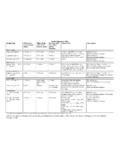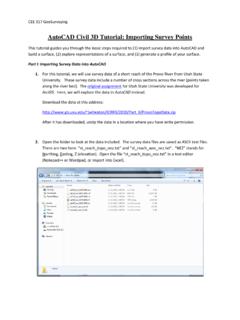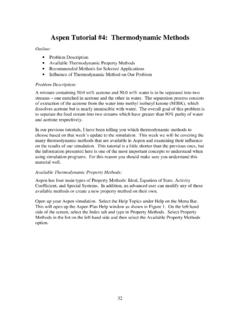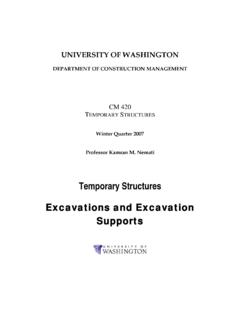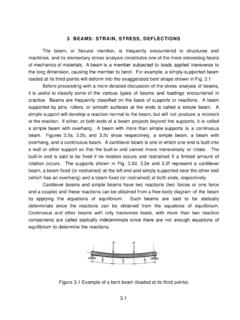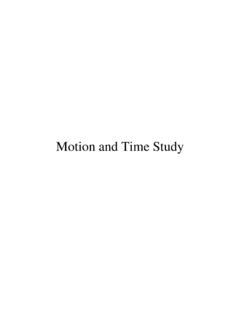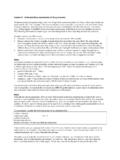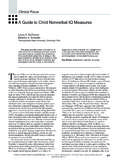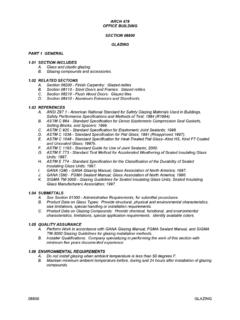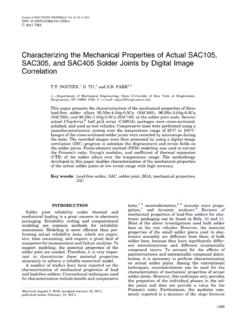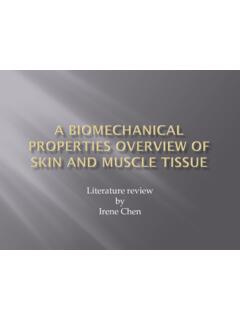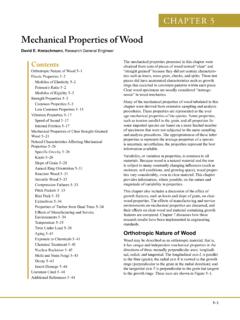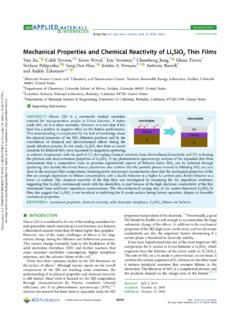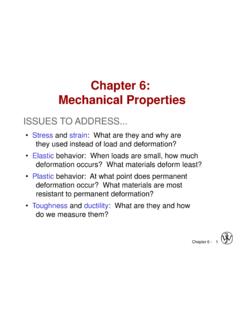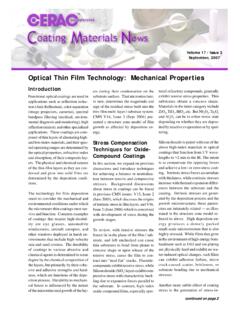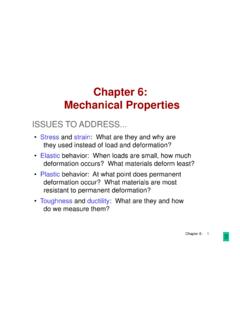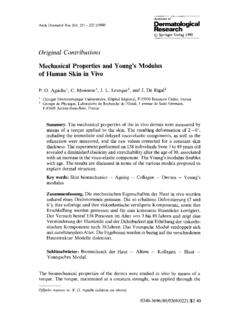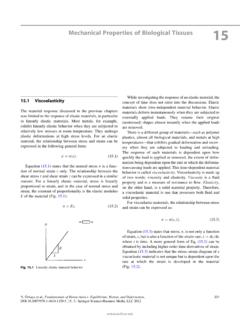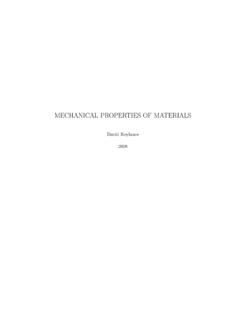Transcription of 5. MECHANICAL PROPERTIES AND PERFORMANCE OF …
1 5. MECHANICAL PROPERTIES AND PERFORMANCE OF MATERIALSS amples of engineering materials are subjected to a wide variety of mechanicaltests to measure their strength, elastic constants, and other material PROPERTIES as well astheir PERFORMANCE under a variety of actual use conditions and environments. The resultsof such tests are used for two primary purposes: 1) engineering design (for example,failure theories based on strength, or deflections based on elastic constants andcomponent geometry) and 2) quality control either by the materials producer to verify theprocess or by the end user to confirm the material of the need to compare measured PROPERTIES and PERFORMANCE on acommon basis, users and producers of materials use standardized test methods such asthose developed by the American Society for Testing and Materials (ASTM) and theInternational Organization for Standardization (ISO).
2 ASTM and ISO are but two of manystandards-writing professional organization in the world. These standards prescribe themethod by which the test specimen will be prepared and tested, as well as how the testresults will be analyzed and reported. Standards also exist which define terminology andnomenclature as well as classification and specification following sections contain information about MECHANICAL tests in general aswell as tension, hardness, torsion, and impact tests in TestingMechanical tests (as opposed to physical, electrical, or other types of tests) ofteninvolves the deformation or breakage of samples of material (called test specimens or testpieces). Some common forms of test specimens and loading situations are shown in Note that test specimens are nothing more than specialized engineering componentsin which a known stress or strain state is applied and the material PROPERTIES are inferredfrom the resulting MECHANICAL response.
3 For example, a strength is nothing more than astress "at which something happens" be it the onset of nonlinearity in the stress-strainresponse for yield strength, the maximum applied stress for ultimate tensile strength, orthe stress at which specimen actually breaks for the fracture of a test specimen is not a trivial matter. However, the simplest testspecimens are smooth and unnotched. More complex geometries can be used toproduce conditions resembling those in actual engineering components. Notches (suchas holes, grooves or slots) that have a definite radius may be machined in notches that produce behaviour similar to cracks can also be used, in addition toactual cracks that are introduced in the specimen prior to Geometry and loading scenarios commonly employed in MECHANICAL testing ofmaterials.
4 A) tension, b) compression, c) indentation hardness, d) cantilever flexure, e)three-point flexure, f) four-point flexure and g) torsionEquipment used for MECHANICAL testing range from simple, hand-actuated devicesto complex, servo-hydraulic systems controlled through computer interfaces. Commonconfigurations (for example, as shown in Fig. ) involve the use of a general purposedevice called a universal testing machine. Modern test machines fall into two broadcategories: electro (or servo) MECHANICAL (often employing power screws) and servo-hydraulic (high-pressure hydraulic fluid in hydraulic cylinders). Digital, closed loopFigure Example of a modern, closed-loop servo-hydraulic universal test ( , force, displacement, strain, etc.
5 Along with computer interfaces and user-friendly software are common. Various types of sensors are used to monitor or controlforce ( , strain gage-based "load" cells), displacement ( , linear variable differentialtransformers ( LVDT's) for stroke of the test machine), strain ( , clip-on strain-gagedbased extensometers). In addition, controlled environments can also be applied throughself-contained furnaces, vacuum chambers, or cryogenic apparati. Depending on theinformation required, the universal test machine can be configured to provide the control,feedback, and test conditions unique to that TestThe tension test is the commonly used test for determining "static" (actually quasi-static) PROPERTIES of materials. Results of tension tests are tabulated in handbooks and,through the use of failure theories, these data can be used to predict failure of partssubjected to more generalized stress states.
6 Theoretically, this is a good test because ofthe apparent simplicity with which it can be performed and because the uniaxial loadingcondition results in a uniform stress distribution across the cross section of the testspecimen. In actuality, a direct tensile load is difficult to achieve (because ofmisalignment of the specimen grips) and some bending usually results. This is notserious when testing ductile materials like copper in which local yielding can redistributethe stress so uniformity exists; however, in brittle materials local yielding is not possibleand the resulting non uniform stress distribution will cause failure of the specimen at aload considerably different from that expected if a uniformly distributed load were typical stress-strain curve normally observed in textbooks with some of the commonnomenclature is shown in Fig.
7 This is for a typical low-carbon steel specimen. Notethat there are a number of definitions of the transition from elastic to plastic behavior. Afew of these definitions are shown in Fig. Oftentimes the yield point is not so welldefined as for this typical steel specimen. Another technique for defining the beginning ofplastic behavior is to use an offset yield strength defined as the stress resulting from theintersection of a line drawn parallel to the original straight portion of the stress straincurve, but offset from the origin of this curve by some defined amount of strain, usually ( = ) or percent ( = 0. 002) and the stress-strain curve itself. The totalstrain at any point along the curve in Fig.
8 Is partly plastic after yielding begins. Theamount of elastic strain can be determined by unloading the specimen at somedeformation, as at point A. When the load is removed, the specimen shortens by anamount equal to the stress divided by elastic modulus ( , Young's modulus). This is,in fact, the definition of Young's modulus E= in the elastic Engineering stress-strain diagram for hot-rolled carbon steel showingimportant PROPERTIES (Note, Units of stress are psi for US Customary andMPa for Units of strain are in/in for US Customary and m/m for materials exhibit stress-strain curves considerably different from carbon-steelalthough still highly nonlinear. In addition, the stress-strain curve for more brittlematerials, such as cast iron, fully hardened high-carbon steel, or fully work-hardenedcopper show more linearity and much less nonlinearity of the ductile materials.)
9 Littleductility is exhibited with these materials, and they fracture soon after reaching the elasticlimit. Because of this property, greater care must be used in designing with brittlematerials. The effects of stress concentration are more important, and there is no largeamount of plastic deformation to assist in distributing the shown in Fig. , often basic stress-strain relations are plotted usingengineering stress, , and engineering strain, . These are quantities based on theoriginal dimensions of the specimen, defined as =LoadOriginal Area=PAo( ) =Deformed length - Original lengthOriginal length=L LoLo( )The Modulus of Resilience is the amount of energy stored in stressing the materialto the elastic limit as given by the area under the elastic portion of the - diagram andcan be defined asUr= d o o20 o ( )where o is the proportional limit stress and o is the strain at the proportional limit is important in selecting materials for energy storage such as springs.
10 Typical valuesfor this quantity are given in Table Modulus of Toughness is the total energy absorption capabilities of thematerial to failure and is given by the total area under the - curve such thatUt= d ( o+Su)20 f f( )where Su is the ultimate tensile strength, o is the proportional limit stress and f is thestrain at fracture. Ut is important in selecting materials for applications where highoverloads are likely to occur and large amounts of energy must be absorbed. Thismodulus has also been shown to be an important parameter in ranking materials forresistance to abrasion or cavitation. Both these wear operations involve tearing pieces ofmetal from a parent structure and hence are related to the "toughness" of the Energy PROPERTIES of materials in tensionMaterialYieldStrength(MPa)Ultimat eStrength(MPa)Modulus ofResilience,(kJ/m3)Modulus ofToughness,(kJ/m3)SAE 1020 annealed276414186128755 SAE 1020 heat treated42762142891047 Type 304 stainless207586103195199 Cast iron172586 Ductile cast iron40050346250352 Alcoa 201727642855262712 Red ductility of a material is its ability to deform under load and can be measuredby either a length change or an area change.

